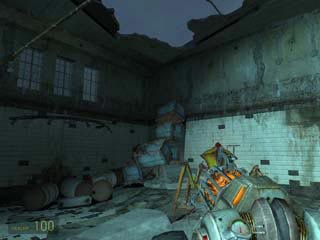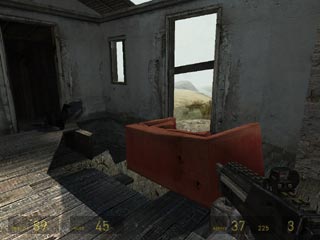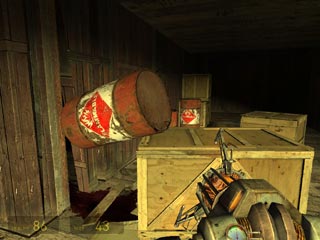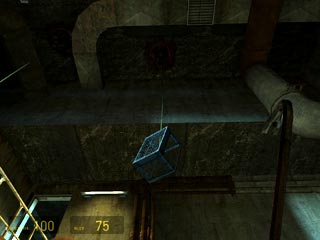
Videogame Physics:
Introduction
Early Video Game Physics
Modern Video Game Physics
Dynamic Objects
Ragdoll Physics
Physics Hall of Shame
Bibliography/Links

Dynamic Objects
Environmental Rigid Body Dynamics
All screenshots on this page were taken by me while playing Valve Software's Half-Life 2 game.
Objects like crates, supports, chunks of concrete, and other parts of the game's landscape that were static in older games can be manipulated by the player and game's inhabitants now. Typically modern games have a basic map created by level designers containing all of the rigid walls, floors, and heavy objects that serve as a playground of sorts for the dynamic objects. Because dynamic objects are computationally expensive, as much of the environment as possible is static. A few examples of dynamic objects in games:

Objects will lean against walls, and bounce off of them in a realistic fashion. Crates and barrels can be stacked on top of each other, allowing the player to reach high ledges.

Creative players can create blockades from these objects, preventing enemies from passing through doors crowded with well-placed dynamic objects.

See-saw objects, like the boards seen here, work in a believable manner. A great example of the new types of gameplay enabled by these realistic physics is a part of Half-Life 2 in which you must stack concrete blocks on the end of a large and heavy see-saw board in order to progress.

All dynamic objects are assigned a weight by the game designers. This is taken into account thoughout all interactions. Throwing a barrel into another barrel will make both tumble to the ground, but throwing a barrel against a heavy chunk of broken concrete will result in the barrel just bouncing off. Heavier objects do more damage if they collide with the player or one of the game's characters.

Objects like saw blades can be used as weapons, allowing the player to invent new ways to destroy enemies. For instance, in Half-Life 2 there is a 'gravity rifle', which allows the player to move and throw large objects. In order to conserve ammunition, the player can use the gravity rifle to launch large saw blades or paint cans at the aliens and zombies in the game.

Static objects can become dynamic when triggered. This bridge, for example, is treated by the game as a static object until the player destroys one of the structures holding it up. It is then treated as a dynamic object capable of falling down.

The enemies and creatures that inhabit the world of Half-Life 2 are also aware of the dynamic objects. One stationary barnacle-like creature has a long tongue which will pick up and begin chewing on anything that happens to touch it. The player can roll an explosive barrel into the tongue, and then ignite it by shooting it when the creature begins to reel it in. Enemey soldiers will hide behind solid objects and blow apart dynamic objects like boards when the player attempts to hide behind them.

Objects will bob and float in the water. When a crate is broken apart in water, the individual pieces of wood float to the surface and drift about. The player can throw broken doors and planks onto the water's surface in order to create a makeshift bridge.

Realistic vehicle physics are also a frequent component of modern videogames. Games such as Bungie Software's Halo have vehicles with simulated suspension systems and gears. Many games also have breakable constraints for crashes, and deformable bumpers. In Half-Life 2, makeshift vehicles can be created by virtually welding together objects like crates with rocket thrusters. As much is simulated as possible given processor speed constraints.